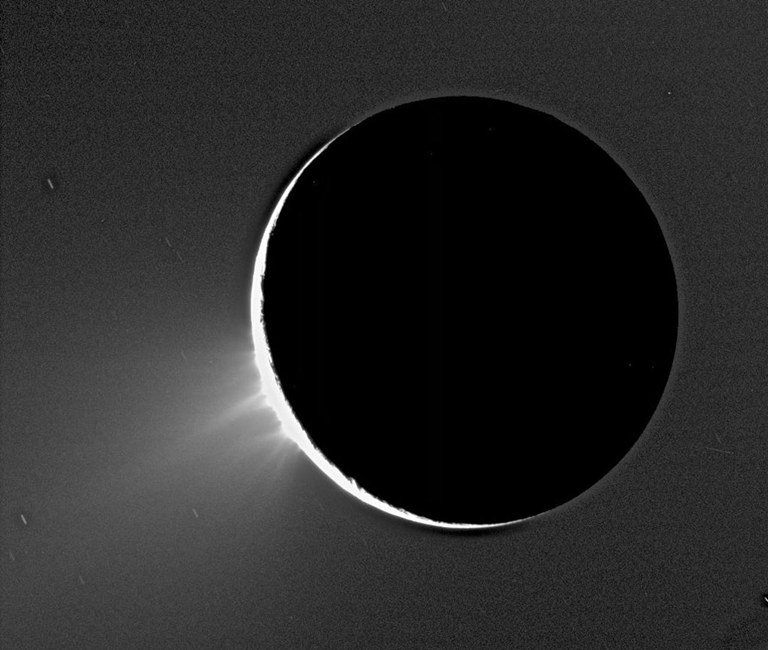A huge doughnut-shaped cloud of water vapor created by the moon encircles Saturn.
By Jet Propulsion Laboratory, Pasadena, California — Published: September 22, 2011
Water vapor and ice erupt from Saturn’s moon Enceladus, the source of a newly discovered doughnut-shaped cloud around Saturn. Credit: NASA/JPL/Space Science InstituteChalk up one more feat for Saturn’s intriguing moon Enceladus. The small, dynamic moon spews out dramatic plumes of water vapor and ice — first seen by NASA’s Cassini spacecraft in 2005. It possesses simple organic particles and may house liquid water beneath its surface. Its geyser-like jets create a gigantic halo of ice, dust, and gas around Enceladus that helps feed Saturn’s E ring. Now, thanks again to those icy jets, Enceladus is the only moon in our solar system known to substantially influence the chemical composition of its parent planet.
In June, the European Space Agency (ESA) announced that its Herschel Space Observatory, which has important NASA contributions, had found a huge doughnut-shaped cloud, or torus, of water vapor created by Enceladus encircling Saturn. The torus is more than 373,000 miles (600,000 kilometers) across and about 37,000 miles (60,000 km) thick. It appears to be the source of water in Saturn’s upper atmosphere.
Though it is enormous, the cloud had not been seen before because water vapor is transparent at most visible wavelengths of light, but Herschel could see the cloud with its infrared detectors. “Herschel is providing dramatic new information about everything from planets in our own solar system to galaxies billions of light-years away,” said Paul Goldsmith from NASA’s Jet Propulsion Laboratory in Pasadena, California.
The discovery of the torus around Saturn did not come as a complete surprise. NASA’s Voyager and Hubble missions had given scientists hints of the existence of water-bearing clouds around Saturn. Then in 1997, ESA’s Infrared Space Observatory confirmed the presence of water in Saturn’s upper atmosphere. NASA’s Submillimeter Wave Astronomy Satellite also observed water emission from Saturn at far-infrared wavelengths in 1999.
While a small amount of gaseous water is locked in the warm, lower layers of Saturn’s atmosphere, it can’t rise to the colder, higher levels. To get to the upper atmosphere, water molecules must be entering Saturn’s atmosphere from somewhere in space. But from where and how? Those were mysteries until now.
Build the model, and the data will come The answer came by combining Herschel’s observations of the giant cloud of water vapor created by Enceladus’ plumes with computer models that researchers had already been developing to describe the behavior of water molecules in clouds around Saturn. …….
Click here to read the full article in the Astronomy.com website

